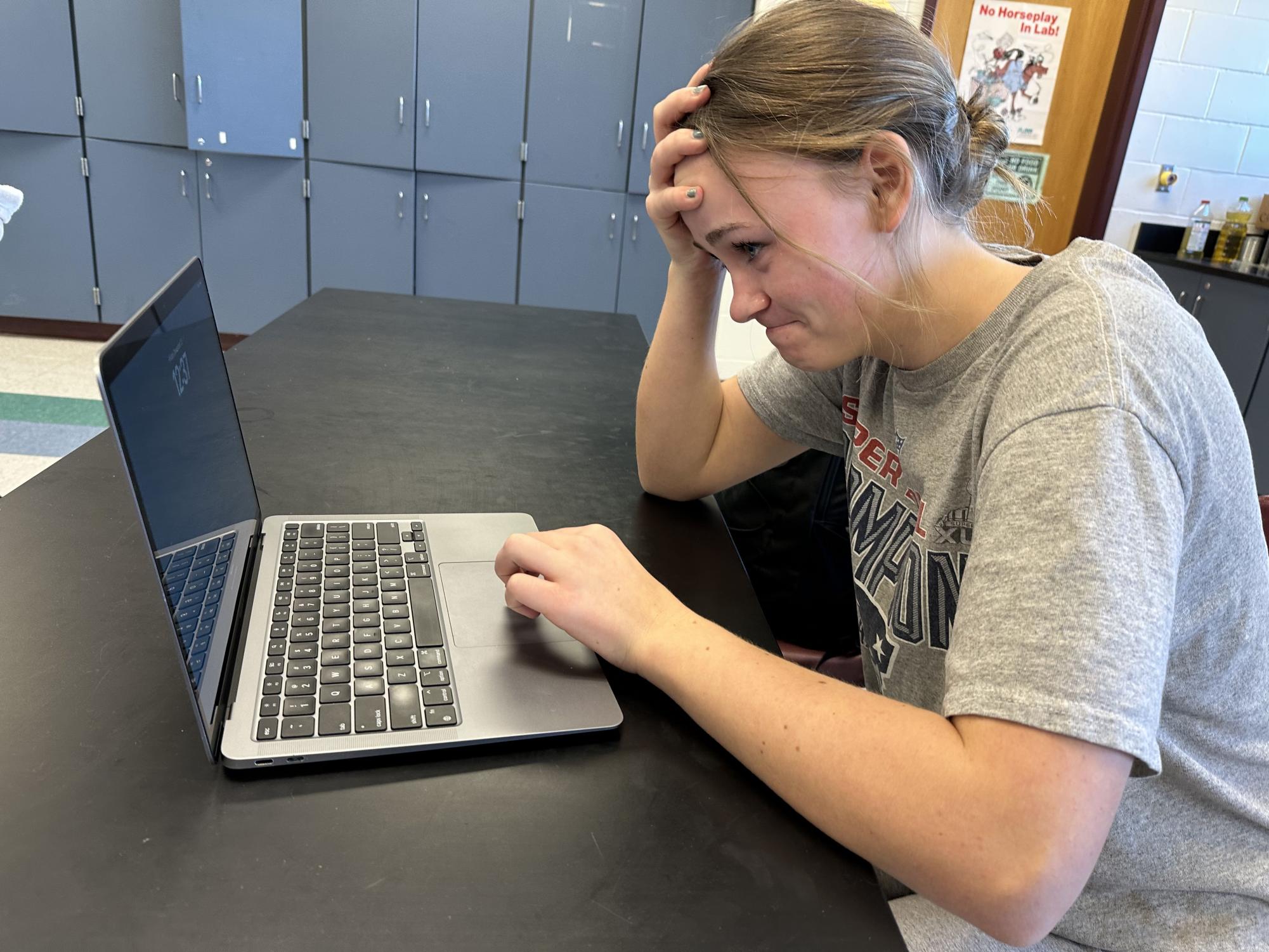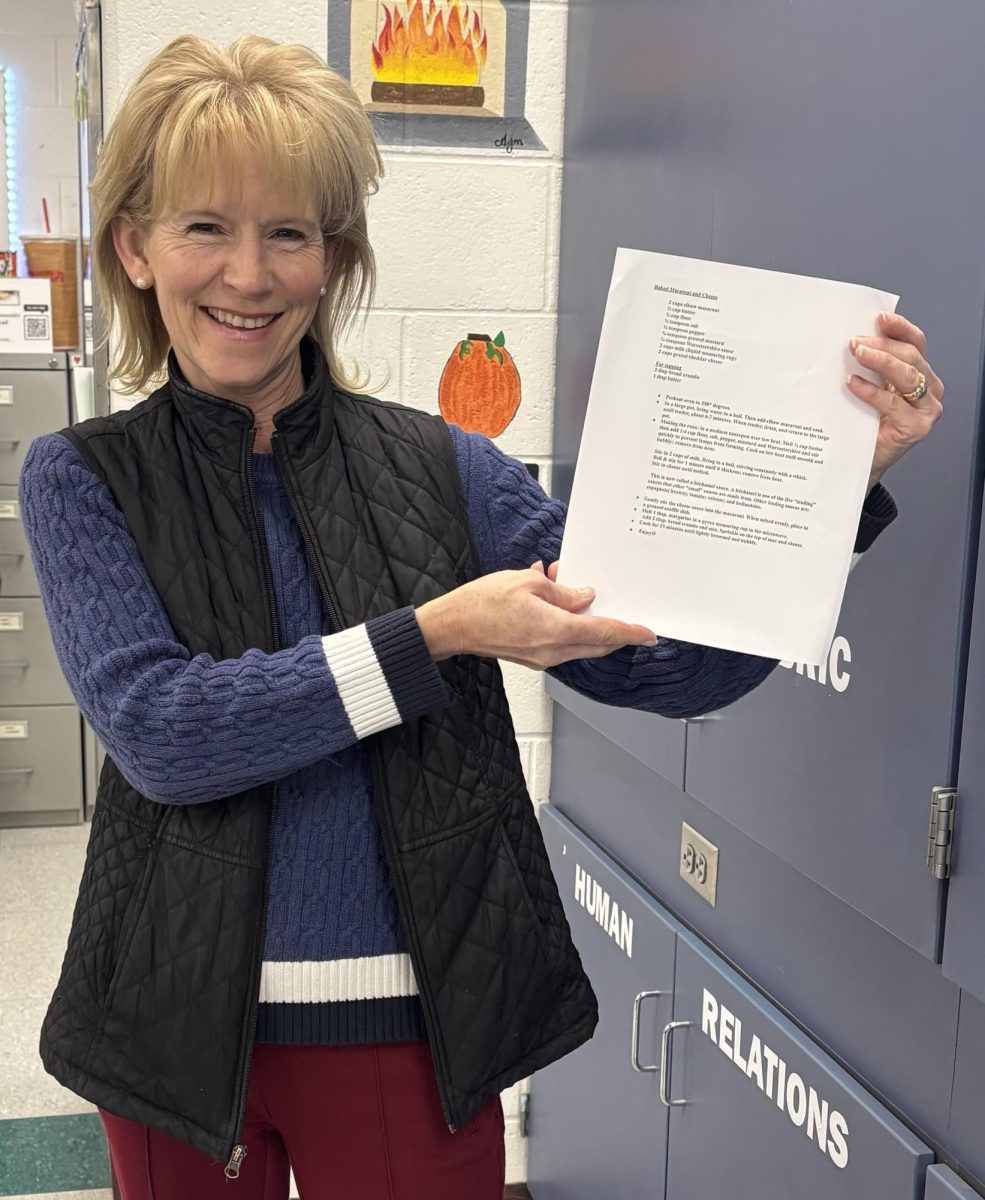Student Health: HB & Beyond

In every teenager’s life, school remains one unifying constant. Through high school and college, students are constantly being enriched and learning from their environments, but one factor that is detrimental to all is seemingly forgotten: mental health. Essential to supporting a healthy lifestyle, a balanced mental state is an important factor to always take into account for students. Unfortunately, course load and general school stressors can lead to unbalanced mental health. To combat these inequities and discover the potential root of the issues, the CavChron sent co-head-editor Finn Brown on a mission.
For years, school stresses and negative effects on mental health have seen a correlation. According to the American Psychological Association, 45% of teenagers experience stress due to school pressures. One of these pressures includes homework and course load, an issue for many teenagers, especially those taking advanced classes. The National Sleep Foundation discovered that more homework leads to less sleep and further risk for depression symptoms. Significant spikes in depression scores were especially prevalent for those students with more than two to three hours of homework. The correlations are staggering and prove that an issue is present, one that can even be found right here at Hollis Brookline.
Angelina Costa is just one of many students who are frontloading their schedules with challenging courses. Currently, in her junior year, Costa is enrolled in five AP classes and one honors class, including AP Language & Composition, AP Calculus and AP Physics I. “First quarter of all the courses was really homework heavy and content heavy,” said Costa ‘25. She found at least four hours of homework each night but expressed that the workload became better as the year progressed.
Stress in students can depend heavily on the time of year as well. School social worker Jillian Burkley—who has been at schools in both the western United States and internationally—has noticed a correlation between harder coursework and greater stress as well as peaks in student stress during certain times. On top of the holiday season, Burkley has observed higher stress in students at the beginning of the school year or a few weeks into it. “Many people may think it’s super exciting because you’ve had a whole summer off but it’s actually the big transition of having to wake up early again, go back to classes and being very rigid,” she explained.
Teachers can play a large role in student mental health as well. As seen in the correlation between more homework and a higher risk of depression symptoms, instructors can put in efforts to benefit students’ mental state with their autonomy over coursework and the amount of it. The number of assignments teachers hand out is not the only way they can aid students, though; connection and understanding between students and teachers is important as well.
Longtime English teacher Lin Illingworth prides herself on the relationships she builds with her students and the work she puts in to improve their mental well-being. “I deliberately take time in the curriculum for connection and community building,” she added. Illingworth also incorporates mental health into her lesson plans through the books she teaches; one noteworthy example is Lord of the Flies, where she goes in-depth to analyze the mental state of the characters. One thing that Illingworth brings to the top of her priorities, though, is balance: “What most people want out of their day is [to] have some laughs with their friends, learn a few things, and not be stressed out.”
Achieving a balance between school and mental health is not a one-and-done process, though. As students’ course load, free time and other factors change, so too does their mental state. Highs and lows are bound to happen, but there is some general advice that all students can benefit from. When it comes to choosing schedules, Costa advises students to “know [their] own limits” and to not “stretch [themselves] too thin.” Additionally, reducing the problems to a school environment does not paint the full picture of achieving mental well-being. “It’s not just school and mental health. It’s gonna be your personal life and family and mental health. It’s gonna be work and mental health,” Burkley added. “Treat it like it is an ongoing development in your life.”
The harmony between school and mental health will always be something for students to manage, but priorities play a crucial role in doing so. Finding the right balance in your courses, reaching out for help when needed and engaging oneself in positive habits are greatly beneficial to such equity and wellness. But, as simply put by Burkley, the bottom line? “Mental health should always be first. Your wellness is first.”
The HBHS Counseling Department offers mental health resources for any student in need, which can be found on the school’s official website.
Although many people think that the stress students face daily occurs only in school, some of the negative effects of such a competitive workload transfer over to home. In 2021, the AAP-AACAP-CHA (American Association of Psychiatrists, American Academy of Child and Adolescent Psychiatry and Children’s Hospital Association) declared a national emergency in child and adolescent mental health. These issues can manifest in every aspect of a student’s personal life, ranging from sleep to work.
The source of all these issues stems from the recent pandemic. During the 2020 Coronavirus outbreak, a mental health study in China was conducted by Xinyan Xie, BA; Qi Xue, MPH1; Yu Zhou, BA; et al. “22.6% of students reported having depressive symptoms…our study found that 18.9% of students reported anxiety symptoms,” the study had found.
Three years after the pandemic began, the major problem with the health of our generation is still the clear lack of sleep students get each night. In a competitive academic race to college, students are filling their schedules with AP classes, internships, research papers, and extracurriculars to get in the lead. “I do feel sleepy when I come back from school, sometimes I take a nap,” said Anuhya Chilakapati ’25.
“The American Academy of Sleep Medicine has recommended that children aged 6–12 years should regularly sleep 9–12 hours per 24 hours and teenagers aged 13–18 years should sleep 8–10 hours per 24 hours,” states the CDC on their website. However, in Hollis and Brookline, it seems like only a small percentage of students meet these guidelines. “I usually get six [hours of sleep],” said Chilakapati.
It’s become a nationwide and global pandemic. “About 7 out of 10 (72.7%) did not get enough sleep on school nights,” states the CDC.
The ignorance of sleep can have negative effects on a student’s well-being, “Children and adolescents who do not get enough sleep have a higher risk of obesity, diabetes, injuries, poor mental health, and problems with attention and behavior,” says the CDC.
Many teenagers also couple school with work to pay for cars and college-related expenses. “I work at a daycare, I work at a nursing home, and I volunteer at the hospital,” said Laurel Geller ’25. Employers deserve dependable employees, but they don’t account for the difference between a high school student and an adult out of school in their schedules. “On the weekend, my last shift at the nursing home was eight hours long,” said Geller.
However, it is important to note that not all students feel stressed or overworked in the same way, or even at all. “I never feel like I am pressured after school. I go home, I do my homework right away, and then I have at least an hour to relax every day,” said Geller. “I think it’s all about time management,” she continues.
What is social health?
A student’s mental health is directly derived from one’s social status. Do they have a lot of friends? Do they partake in school activities? Do they have a lot of followers on social media? It is all connected.
Social health can be defined as our ability to interact and form meaningful relationships with others. Following the pandemic, there has been an observable decrease in the social skills of teenagers, especially with the increase of technology use. “I have definitely seen a decline in kids’ mental health, specifically their social involvement, and technology plays a role in that. Technology is great and it is easier to make those social connections, but at the same time it can be harmful and challenging, so I have definitely seen a decline,” said Hollis Brookline High School psychologist Eric Penniman.
Why is social health important?
Students’ social health and wellness affect one’s overall well-being. Being involved in your school community gives “you importance. You have a place, people are counting on you, and you will be looking forward to talking to people too,” said Penniman.
It is important for students to stimulate their minds in different ways. This can be seen as partaking in a sport, clubs after school, and simply just learning in school. Students, however, receive a large amount of their stimulus through cell phone use which leads to self-imposed isolation “because you can get stimulus from cell phone consumption where you don’t have to interface with others, so you’re not putting yourself in those stressful situations and collaborative situations that force us to reflect on our own behaviors and act in ways that we perceive others and how others are expecting us to act,” said HBHS psychology teacher Justin Ballou.
Social isolation
Forming relationships is what makes students feel involved in their community. It makes students feel important, and when they have poor social health and impose social isolation upon themselves, there tends to be a decrease in both mental and physical health. “When people are socially connected and have stable and supportive relationships, they are more likely to make healthy choices and to have better mental and physical health outcomes,” states the Centers for Disease Control and Prevention.
Being socially isolated from oneself leads to negative thoughts constantly flowing through one’s mind. Because of this, those who are socially isolated are increasing the risk of obesity, inflammation and high blood pressure.
How to identify poor social health
“When you are not involved, I think it leads to isolation, thoughts running rampant, and what you’re thinking is not necessarily true, but by being around other people, they can challenge your thinking,” said HBHS guidance counselor Mary Carper.
According to Carper, the following aspects are some signs that one may be suffering from poor social health:
- Social isolation
- Low self-esteem
- Anxiety
- Depression
- Poor immune system
- High blood pressure
How to identify healthy social health
The following aspects are signs that one has good social health:
- Comfortable being themself
- Being assertive but not passive or aggressive
- Good balance between social time and alone time
- Being a part of the community
- Able to adapt in different social situations
- Treating others with respect
- Being able to develop and maintain friendships
- Creating boundaries in friendships to encourage communication and conflict management
- Having a supportive group of family and friends
How to improve social health
Start with self-care → you can achieve this by eating a balanced diet, staying active, stimulating your mind, and getting enough sleep. It is important to be happy with yourself before you find happiness in others
Making friends! Everyone finds it intimidating to meet new people. However, by reaching out or starting small talk with others, you are giving your brain that social stimulus it needs to be healthy.
Working on communication skills is critical to keep healthy relationships with others. Simple gestures that demonstrate strong communication skills can be seen as maintaining eye contact when having a conversation, being a good listener, and being aware of your body language.
Social health is important to everyone, especially students, with the rising use of technology. Seeing a decline in students’ social health is devastating because “in order to improve mental health we have to be able to make connections. All that is part of being social is making positive connections with everyone around you, versus when we are isolated, we do not have that outlet. Because of that, that can really weigh down on someone and their mental health when they feel kind of alone and isolated on their own little island,” said Penniman.
A balanced social health, as connected with mental health, is essential for students’ well-being. For those struggling with either, resources and help can be provided by the HBHS Guidance Department.
Physical health is a constantly overlooked part of teens’ growth. Many people are unaware that having good physical health is interlinked with many different parts of students’ health overall. Taking care of your body such as eating healthy, getting enough sleep, and exercising all have an impact on doing well in school, as well as keeping yourself as healthy as possible.
Understanding the importance of physical health when growing is crucial to students’ overall well-being. Physical health is one of the most important factors in school performance, as well as just simply staying healthy. “Physical activity, of any kind, can benefit teens in more ways than they probably realize. It helps to keep bones and muscles strong, promotes brain health and decreases the chance of illness and disease,” said Laurel Bakker, the wellness teacher at HBHS. Bakker brings up an interesting point, as constant physical activity also has the ability to decrease the chances of illness as well.
According to MedlinePlus, “exercise strengthens your heart and improves your circulation. The increased blood flow raises the oxygen levels in your body. This helps lower your risk of heart diseases such as high cholesterol, coronary artery disease, and heart attack.”
Studies show from the National Library of Medicine that if kids participate in physical activity before a test/quiz they are more likely to get a higher score. “Kids that do some type of physical activity before they take a test are more likely to have higher test scores than a kid who didn’t do that,” said Nicole Fortuna, gym teacher at HBHS. Results of a study done at Dartmouth showed that people who walked outside for 20 minutes before a test/quiz got higher scores, regardless of being fit or not. Once you factor in physical activity into your normal lifestyle, things start to change around you.
“Participating in physical activity can also be a great way to reduce stress,” said Brian Bumpus, the athletic director at HBHS. Bumpus brings up stress, which is a quite common factor in high school students. One of the most common ways to battle stress is exercising. “As you move your body, your brain produces endorphins,” added Fortuna. Stress is a major factor in students’ overall well-being as they begin to ascend into adulthood. Constant physical activity is a major help in trying to combat that stress and staying as healthy as possible.
The interconnection between physical health and all other forms of wellness is crucial to understand when growing. Being able to stay physically healthy is not only going to make your body stronger, but it also helps your mind. Being able to prioritize your physical health will help ensure steady growth.








![Dr. Barry teaches his son Benin karate as part of a class he provides for school-aged children across Brookline. “I happen to have [karate classes] thrown into the mix of what I do here, because it’s something that I have to offer,” he says. “I enjoy it, I can do it, and I can offer it freely.” (Courtesy Brian Barry)](https://cavchronline.com/wp-content/uploads/2025/04/Man-of-Many-Talents-Brian-Barrys-Service-to-Brookline.jpg)
